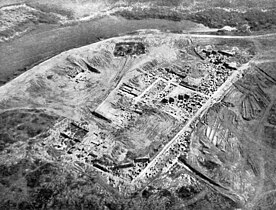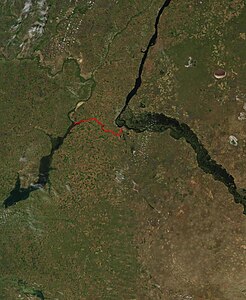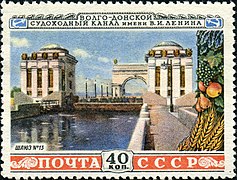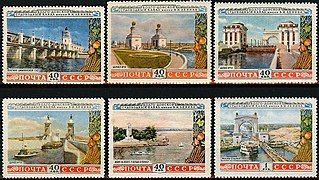Volga–Don Canal
| Volga–Don Canal | |
|---|---|
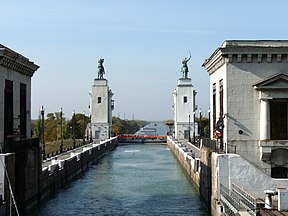 Volga–Don Canal in October 2009 | |
 | |
| Specifications | |
| Length | 63[1] miles (101 km) |
| Maximum boat length | 141 m (463 ft)[2] |
| Maximum boat beam | 16.8 m (55 ft)[2] |
| Maximum boat draft | 3.6 m (12 ft)[2] |
| Locks | 13[3] |
| Maximum height above sea level | 144 ft (44 m) |
| Status | Open |
| History | |
| Construction began | 1948 |
| Date of first use | 1 June 1952 |
| Date completed | 1952 |
| Geography | |
| Start point | Volgograd, Russia |
| End point | Tsimlyansk Reservoir, near Volgodonsk, Russia |
| Beginning coordinates | 48°37′21″N 43°32′06″E / 48.62250°N 43.53500°E |
| Ending coordinates | 48°31′21″N 44°33′09″E / 48.52250°N 44.55250°E |
Lenin Volga–Don Shipping Canal (
The canal forms a part of the
History
There has been a trade and military route between the
The presence of the fortified settlement Tanais in the Don River delta since the time of the Bosporan Kingdom, c. 438 BC– 370 AD, strongly suggests the route was sufficiently notable to be fortified for over two thousand years. The Sarkel fortress on the left bank of the lower Don was the main control of this Volga trade route.[4]
The Don–Volga portage got its name from its trade importance 1000 years ago.[5]
In 1569, the
In 1711 Russia left Azov under the terms of the Treaty of the Pruth, and Peter the Great lost all interest in the canal, which was abandoned and fell into ruin.[16][17] Over time, other projects for connecting the two rivers were proposed, but none were attempted. However, the horse-drawn Dubovsko-Kachalinsky railway and the Volga–Don railway — now part of the South Eastern Railway — were built in 1846 and 1852, respectively, to link the Volga and the Don at the shortest distance.[18] They were 68km and 73km long respectively.[19][20]
The construction of today's Volga–Don Canal, designed by
Upon completion, the Volga–Don Canal became an important link in the
Operation
The canal begins at the Volga's Sarepta backwater (48°31′10″N 44°33′10″E / 48.51944°N 44.55278°E, the location of Lock No. 1 and the gateway arch), south of
The smallest locks are 145 m (476 ft) long, 17 m (56 ft) wide, and 3.6 m (12 ft) deep. The maximum allowed vessel is 141 m (463 ft) length, 16.8 m (55 ft) beam, and 3.6 m (12 ft) draught (the Volgo–Don Max Class).[2]
The canal is filled from the Don, with three powerful pumping stations to maintain water levels. Water is also taken from the canal for irrigation.
Cargo transported from the Don region to the Volga includes coal from
Tourist cruisers travel in both directions.

The canal and the
The Russian
According to the Maritime Board (Morskaya Kollegiya) of the Russian government, 10.9 million tonnes of cargo were carried over the Volga–Don Canal in 2004.[21] An alternative source claims 8.05 million tonnes of cargo was transported through the canal in 2006. Most of the cargo was moved from the east to the west: 7.20 million tonnes, and only 0.85 million tonnes the other way. Just over half of all cargo was oil or oil products (4.14 million tonnes), predominantly shipped from the Caspian region.[22]
It was reported in 2007 that in the first 55 years of the canal's operations 450,000 vessels had passed through carrying 336 million tonnes of cargo. Recent cargo volume stood at 12 million tonnes per year.[23]
In 2016, the core of
Stamp gallery
-
USSR stamp, 1953: Lock No. 13
-
USSR stamp, 1951
-
USSR stamp, 1952
-
Russia Stamp 2008
-
USSR collection
-
Illustration of a lock on the Volga–Don Canal (1953) (47°33′5.84″N 42°08′10.26″E / 47.5516222°N 42.1361833°E)
-
Tsimlyansk hydroelectric power plant (1953)
Future options
In the 1980s, construction started on a second canal between the rivers. The new canal, dubbed Volga–Don 2 (
As of 2007–2008, Russian authorities are considering two options for increasing the
See also
References
- ^ Сроки работы шлюзов (Lock operation periods), from the site of the Russian Shipping Companies' Association (in Russian)
- ^ ISBN 9781315643496. Retrieved 19 May 2020.
- ^ "Volga-Don Canal - canal, Russia". Encyclopedia Britannica. Retrieved 20 April 2018.
- ^ Elhaik E(2020)Diverse genetic origins of medieval steppe nomad conquerors – a response to Mikheyev et al(2019).
- ^ "CA&CC; Press AB". Archived from the original on 20 July 2009.
- ^ a b c Giancarlo Casale. The Ottoman Age of Exploration. pp. 135–7.
- ^ Halil İnalcık. The Origin of the Ottoman-Russian Rivalry. pp. 79–80.
- ISBN 9780521563819.
The project was abandoned when one-third complete
- ^ Colin Imber. The Ottoman Empire, 1300-1650: The Structure of Power. p. 44.
- ^ A. N. Kurat. "The Turkish Expedition to Astrakhan' in 1569 and the Problem of the Don-Volga Canal".
{{cite journal}}: Cite journal requires|journal=(help) - ^ "Where is the Volga-Don Canal?". 25 April 2017.
- ^ "Город Петров Вал (Волгоградская область)".
- ^ Ilovlya (river in the RSFSR) // Great Soviet Encyclopedia : [in 30 vol.] / Ch. ed. A.M. Prokhorov . - 3rd ed. - M .: Soviet Encyclopedia, 1969-1978.
- ^ Minh A. N. Historical and Geographical Dictionary of the Saratov Province / Comp. A.N. Minh. - Saratov, 1898-1902. - 5 t. - App. To the Works of the Saratov Scientific Archival Commission. - S. 383
- ^ Milena Zolotareva (January 2019). "Environmental planning and management of waterway construction (historical experience of Russia in the 18th century and the beginning of the 19th century)" (PDF).
- ^ Плечко Л.А.: Старинные водные пути. Сервер для туристов и путешественников Скиталец. Информационный сервер обо всех видах туризма (in Russian). Archived from the original on 17 March 2019. Retrieved 20 April 2018.
- ^ это... Что такое Ивановский канал?. Словари и энциклопедии на Академике (in Russian). Retrieved 20 April 2018.
- ^ Skolkov G.S. Tsaritsyn-Stalingrad in the past . - Stalingrad: Edition of the Stalingrad island of local history, 1928. - T. The first essay, 1589-1862.
- ^ Collection of freight surface distances of Russian railways / Comp. I.F.Sauer. - St. Petersburg: Br. Panteleev, 1893. - S. 10. - 114 p.
- ^ Minh A.N. Dubovsko-Kachalinskaya railway // Historical and geographical dictionary of the Saratov province. - Saratov: Printing house of the provincial zemstvo, 1898. - T. 1, issue 2. - S. 276-277.
- ^ Морская коллегия: Речной транспорт Archived 7 March 2008 at the Wayback Machine (Maritime Board: River Transport) (in Russian)
- ^ "Взвесить все" (Supplement to the Kommersant newspaper, No. 195/P(4012), 27.10.2008 (in Russian)
- ^ «Водный мир» для Евразии ("Eurasia's 'Water World'"; Archived 4 March 2008 at the Wayback Machine), Transport Rossii, No. 28 (472) 12 July 2007 (in Russian).
- ^ "В Белоруссию привезли первый реактор для строящейся АЭС".
- ^ a b Петр ГОДЛЕВСКИЙ, «ВОЛГО-ДОН 2» — ШАГ В БУДУЩЕЕ Archived 22 July 2011 at the Wayback Machine. «Торговая газета», номер 4-5(434—435) от 23.01.2008
- ^ D. J. Peterson, «Troubled Lands: The Legacy of Soviet Environmental Destruction»Chapter 3
- ^ "ВОЛГО-ДОН-II: МЫ СТРОИЛИ, СТРОИЛИ И ЧТО?" (We have been building... So what?") Журнал «Власть» (Kommersant-Vlast Magazine), No. 30, 30.07.1990 (in Russian)
- ^ "Строительство второго Волго-Донского канала, на нужды которого в свое время было затрачено 750 миллионов рублей, было заморожено 10 лет назад. А приехавшие по призыву комсомола люди так и остались там жить." (14.11.2000)
- ^ Nazarbayev insists on Eurasian canal construction Archived 5 May 2005 at the Wayback Machine Kazinform, 22 May 2008
- ^ "Analysis: Russia, Kazakhs eye rival canal". United Press International. Archived from the original on 9 February 2008.


